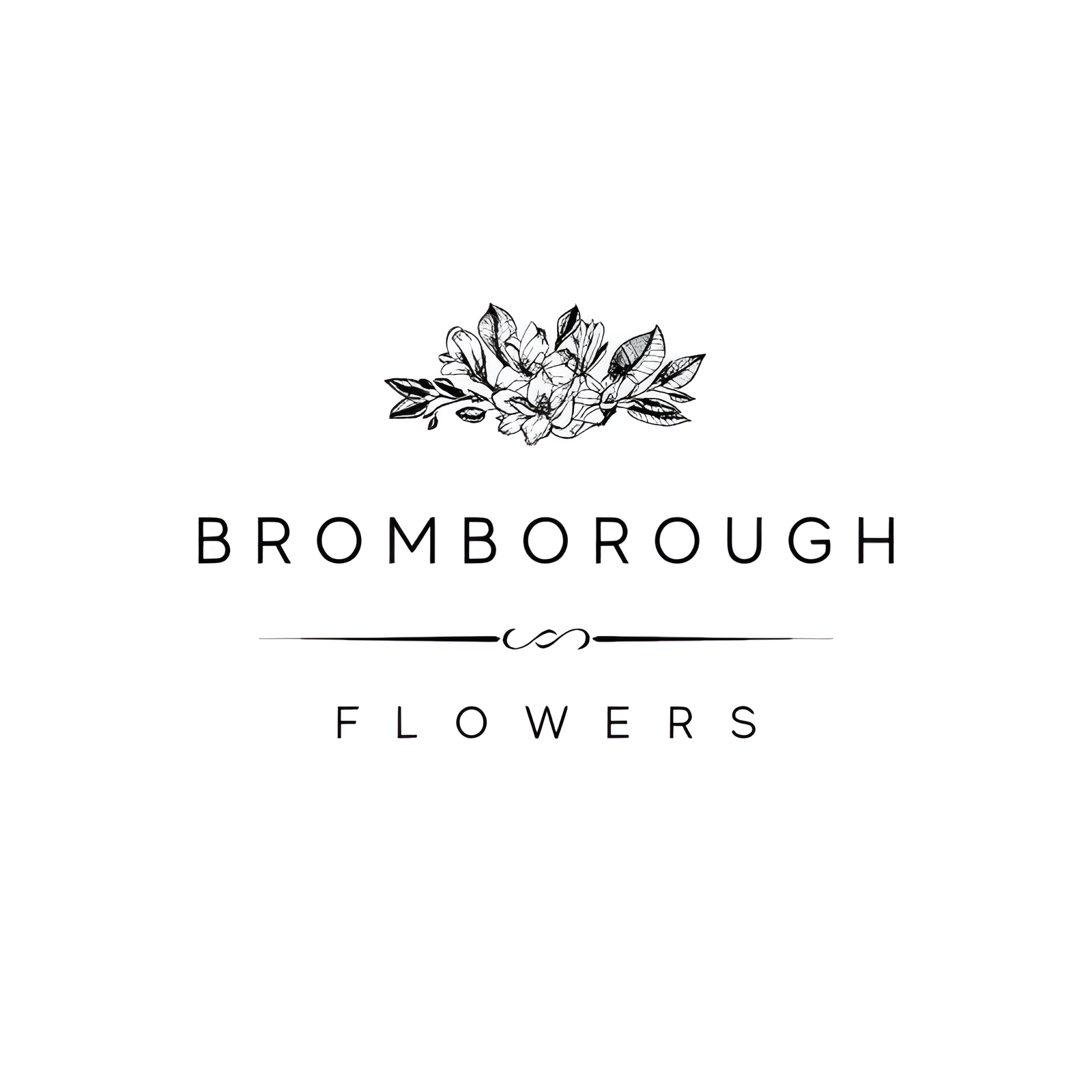When planning the floral elements of a wedding, the hyacinth emerges as a distinguished choice, marrying elegance with a fragrant allure. This flower’s densely packed, star-shaped blossoms come in a spectrum of hues such as blue, peach, and lavender, making it a versatile option for various decorative applications. Beyond its visual appeal, the hyacinth’s rich symbolism of love, beauty, and joy adds a meaningful layer to any celebration. Yet, understanding its taxonomy, growing conditions, and cultural significance can further illuminate its suitability for your special day. How does this charming flower integrate into different wedding themes and traditions?
Flower Overview
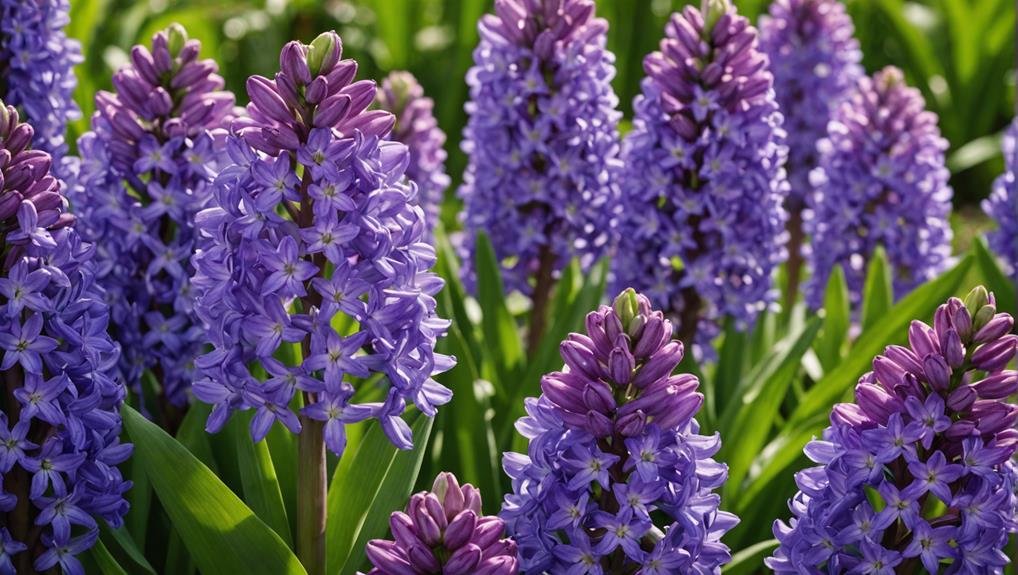
Hyacinths, belonging to the Hyacinthaceae family, are fragrant spring flowers native to the eastern Mediterranean, west Iran, and Turkey, and are available in a variety of vibrant colors such as blue, peach, red, violet, and lavender. These flowers are renowned for their strong, pleasant fragrance and vivid hues, making them a popular choice for diverse floral arrangements.
Hyacinths are particularly favored for wedding decorations, especially during the holiday season. Their bright, eye-catching colors and delightful scent add a touch of elegance and festivity to wedding bouquets, centerpieces, and other floral elements.
Commonly grown under glass in Holland, hyacinths are sold in wraps of 25 stems, with stem lengths ranging between 25-35 cm tall. This uniformity in stem length and quality makes them ideal for creating cohesive and aesthetically pleasing arrangements.
When incorporating hyacinths into wedding floral designs, adhering to proper care guidelines is vital. Conditioning them in clean buckets with lukewarm water helps maintain their freshness. It is also important to avoid direct sunlight and heat sources to prolong their vibrant appearance.
Importantly, hyacinths should not be conditioned with daffodils, as the latter’s sap can be harmful.
Physical Description
Often admired for their striking appearance, these fragrant blooms feature dense clusters of star-shaped flowers atop sturdy, upright stems. Hyacinths, a popular choice for wedding flowers, exude a delicate charm that enhances any bridal arrangement.
Belonging to the Hyacinthaceae family, these flowers are closely related to Grape Hyacinths (Muscari) and are native to the eastern Mediterranean, west Iran, and Turkey. This origin contributes to their robust and resilient nature.
The stems of hyacinths, which are typically between 25-35 cm tall, provide a substantial base for the dense clusters of their delicate blooms. When purchased wholesale, they are commonly sold in wraps of 25 stems, making them convenient for large floral arrangements.
Their star-shaped flowers are tightly packed together, creating a visually appealing, textured effect that is both elegant and eye-catching.
The structure of hyacinths, with their upright stems and compact floral clusters, makes them ideal for wedding bouquets, centerpieces, and other decorative elements. Their vibrant presence and sweet fragrance add a timeless, romantic touch to wedding celebrations, especially during the holiday season when their popularity peaks.
Available Colour Varieties
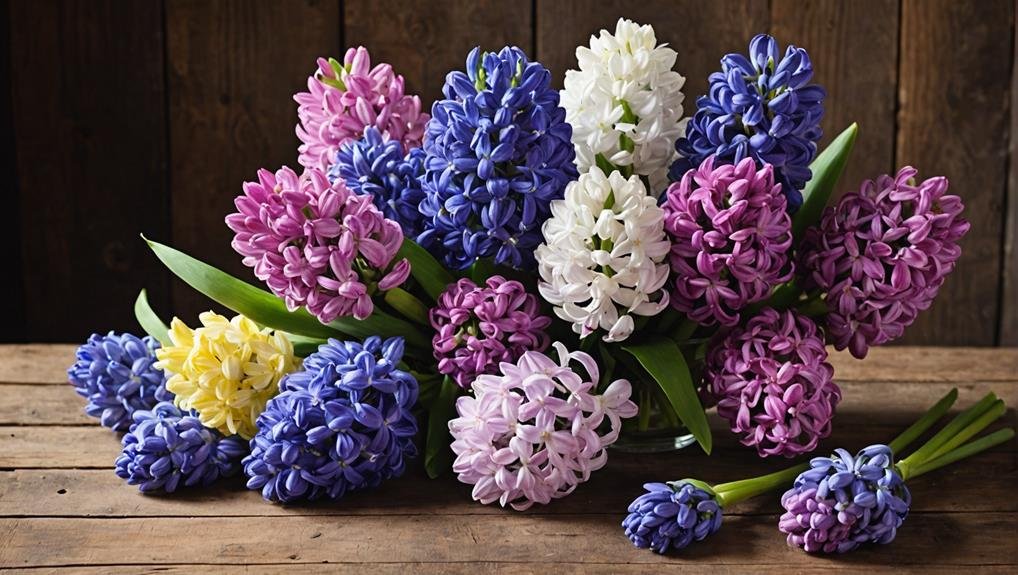
With a palette ranging from vibrant blues to soft peaches, hyacinths offer an impressive array of color varieties for wedding floral arrangements. As a quintessential spring flower, hyacinths are cherished for their diverse hues and unique fragrances, making them a versatile choice for various wedding themes.
Pink hyacinths, in particular, are symbolic of love, beauty, joy, playfulness, and romance, making them an ideal selection for wedding bouquets and centerpieces. The soft, romantic tones of pink hyacinths can add a delicate touch to bridal arrangements, enhancing the overall aesthetic of the event.
In addition to pink, hyacinths are available in a variety of other colors, including blue, red, violet, and lavender. Each color not only brings its own distinct fragrance but also allows for creative combinations that can be tailored to match the wedding’s color scheme. Blue hyacinths are often used to convey tranquility and stability, while lavender hyacinths represent grace and elegance.
Originating from Turkey and the Middle East, hyacinths are now mainly grown in Holland, ensuring their availability for spring weddings worldwide. This wide range of colors and meanings makes hyacinths a versatile and cherished choice for any wedding celebration.
Latin Name and Taxonomy
The Latin name for the hyacinth, Hyacinthus orientalis, situates this beloved flower within the Hyacinthaceae family. This classification highlights its botanical connections to other members of the Hyacinthaceae, including the Grape Hyacinth, known scientifically as Muscari.
Both Hyacinthus orientalis and Muscari share common characteristics, such as their bulbous nature and fragrant blooms, which make them popular choices for various floral arrangements.
Hyacinthus orientalis is distinguished by its vibrant, densely clustered flowers and is widely celebrated for its rich, intoxicating fragrance. This species’ taxonomy underscores its unique position within the plant kingdom, with a lineage that traces back to the eastern Mediterranean, west Iran, and Turkey.
The genus name, Hyacinthus, is derived from Greek mythology, symbolizing beauty and rebirth, which adds a layer of historical and cultural significance to its use in weddings.
Grape Hyacinths, although related, differ in appearance with their smaller, grape-like clusters of flowers. Both types, however, are cultivated extensively, particularly in Holland, where they are grown under glass to produce a variety of colors.
This cultivation practice guarantees a steady supply of high-quality blooms for festive occasions year-round.
Geographical Origins
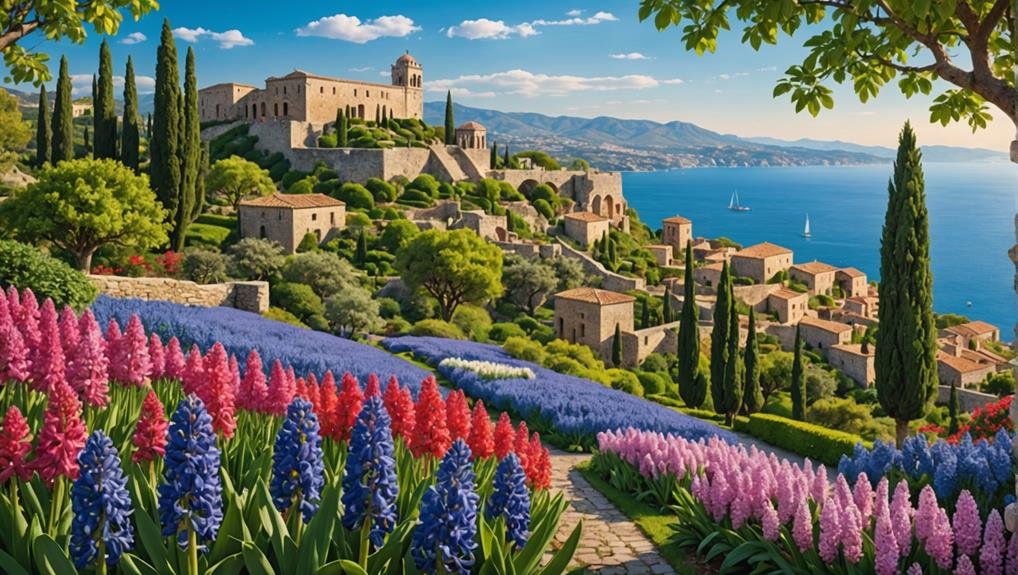
Tracing its roots back to Turkey and the Middle East, the hyacinth has a storied past that complements its botanical significance. This exquisite flower originally flourished along the eastern shores of the Mediterranean, with its earliest cultivation believed to have taken place in Constantinople during the sixteenth century. The historical journey of the hyacinth from its ancient beginnings to its present-day popularity is as captivating as its vibrant blooms.
Today, while the hyacinth is mainly cultivated in Holland, its geographical origins remain a cornerstone of its identity. The flower’s association with ancient Greek mythology and its inclusion in the asparagus family further enrich its cultural and botanical heritage. The distinct scents of hyacinth flowers, varying by color, have made them a staple in the perfume industry and a beloved element in floral arrangements.
Key aspects of hyacinth’s geographical origins include:
- Eastern Mediterranean roots: Originated along the eastern shores of the Mediterranean.
- Historical cultivation: First grown in Constantinople in the sixteenth century.
- Current cultivation: Mainly cultivated in Holland today.
- Mythological ties: Rich history in ancient Greek mythology.
- Fragrance: Each color variant has a unique scent, popular in perfumes.
These geographical origins lend the hyacinth a unique appeal, making it a cherished choice for weddings and home décor alike.
Season Availability
Hyacinths typically bloom in the spring, specifically during March and April, making them ideal for spring weddings. This seasonal availability aligns perfectly with the timing of many nuptials, providing an opportunity to incorporate these vibrant and fragrant flowers into wedding arrangements.
The peak bloom period of hyacinths coincides with the Easter season, further enhancing their popularity for springtime celebrations.
The abundance of hyacinths during these months guarantees access to fresh and high-quality blooms. This is particularly advantageous for wedding planners and brides seeking to create stunning floral displays. Depending on the region and climate, hyacinths may be available slightly earlier or later in the season. For instance, warmer climates might see an earlier bloom, while cooler regions may experience a delayed onset.
The spring season not only secures the availability of hyacinths but also highlights their natural beauty. The vibrant colors and intoxicating fragrance of hyacinths are best appreciated during this time, making them a quintessential choice for spring weddings.
Growing Conditions
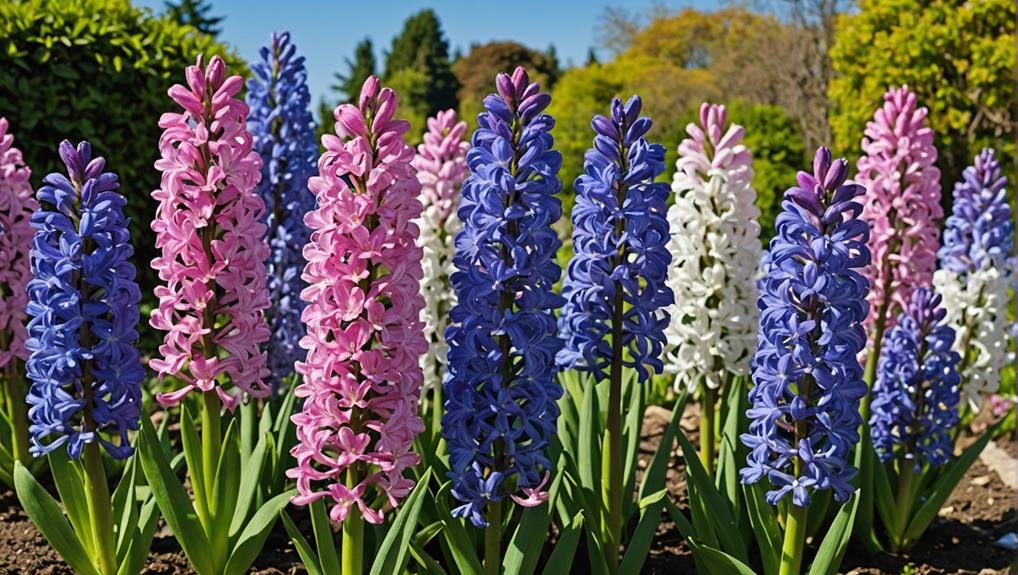
Best growth of hyacinths requires well-drained soil and exposure to full sun or partial shade. These flowers thrive particularly well in USDA hardiness zones 4-8, where they can tolerate colder temperatures.
Proper planting is essential for their development; bulbs should be planted in the fall to guarantee a spectacular bloom in the spring. Spacing the bulbs 6-8 inches apart allows each plant ample room to grow and flourish.
Regular watering is vital for hyacinths, but it is important to avoid overwatering, as this can lead to bulb rot. To further promote healthy growth, a layer of mulch can be applied. This helps retain moisture and suppress weeds, creating an ideal environment for the plants.
Key considerations for growing hyacinths include:
- Soil: Ensure it is well-drained to prevent waterlogging.
- Sunlight: Provide full sun or partial shade.
- Planting Time: Plant bulbs in the fall for spring blooms.
- Spacing: Maintain a distance of 6-8 inches between bulbs.
- Watering: Regular, but moderate, to avoid rot.
Cultural Significance
The hyacinth flower holds a profound place in numerous cultures and traditions, symbolizing love, beauty, and rebirth. Its origins trace back to ancient Greek mythology, where it is linked to the tragic tale of Hyacinthus, a beautiful youth loved by the god Apollo. This rich mythological background imbues the flower with deep symbolic meaning, making it a poignant choice for various ceremonies and celebrations.
Hyacinths were first cultivated in Constantinople in the sixteenth century and have since become primarily associated with Holland, where they are extensively grown today. Each hyacinth color boasts a unique fragrance, contributing to their popularity in perfume making and enhancing their appeal in floral arrangements. This diverse range of fragrances adds a romantic touch to any setting, whether it be in a garden or a bouquet.
These flowers were originally found along the eastern shores of the Mediterranean and are related to asparagus. Their historical and geographical journey underscores their versatile cultural significance and enduring popularity.
| Aspect | Details | Significance |
|---|---|---|
| Mythology | Greek myth of Hyacinthus | Symbolizes love and beauty |
| Origin | Constantinople, 16th century | Historical cultivation |
| Fragrance | Unique scents per color | Popular in perfumes, romantic touch |
The hyacinth’s blend of historical depth and sensory appeal continues to make it a cherished symbol across cultures.
Typical Use in Weddings
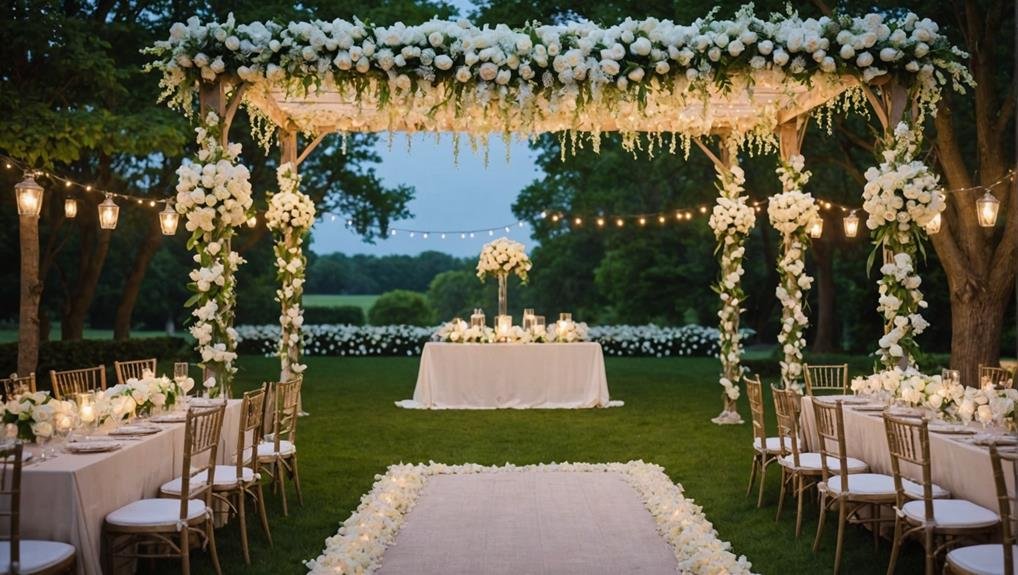
Incorporating hyacinths into wedding floral arrangements brings a touch of seasonal elegance and romantic symbolism to the occasion. Known for their sweet fragrance and vibrant colors, hyacinths are a popular flower choice for spring weddings. Their presence in wedding bouquets signifies sincerity and genuine love, making them ideal for couples looking to express deep emotions.
Pink hyacinths, in particular, are cherished for their symbolic representation of love, beauty, joy, and playfulness. These attributes align perfectly with the essence of a romantic wedding theme. Hyacinths can be seamlessly integrated into various bouquet styles, including classic round, cascading, hand-tied, and rustic and wild bouquets.
To enhance the aesthetic appeal, hyacinths are often paired with greenery such as eucalyptus, fern leaves, ivy, and dusty miller. This combination not only adds texture but also creates a visually appealing contrast that elevates the overall floral arrangement.
Here are some popular ways to use hyacinths in wedding floral arrangements:
- Bridal bouquets: Adding a central or accent role in the bouquet.
- Boutonnieres: For a touch of elegance in the groom’s ensemble.
- Centerpieces: Creating stunning table arrangements.
- Ceremony arches: Adding a fragrant touch to the wedding backdrop.
- Aisle decorations: Lining the aisle for a romantic entrance.
Alternative Flower Types
Exploring alternative flower types such as daffodils, tulips, and lilies can add unique charm and symbolism to wedding floral arrangements. Daffodils, with their cheerful spring colors, are a wonderful choice for those seeking to infuse a lively and optimistic atmosphere into their wedding decor. Available in a variety of shades including white, butter, peach, coral, and orange, daffodils can be tailored to match any wedding color scheme.
Tulips, renowned for their versatility, offer a wide range of colors and shapes, making them ideal for intricately designed bouquets and arrangements. Their elegant petals can convey different moods and themes, from the simplicity of a white tulip to the vibrant statement of a red or purple one. This flexibility allows tulips to complement both traditional and modern wedding styles seamlessly.
Lilies, known for their symbolic meanings based on color, bring depth and sentiment to floral displays. White lilies symbolize modesty, orange lilies represent passion, and yellow lilies denote gaiety. This makes them a fitting choice for couples who wish to imbue their wedding with personal significance and emotional resonance.
For those seeking further variety, consider incorporating larkspur, lavender, or anemones to enhance the aesthetic and symbolic richness of your wedding arrangements.
